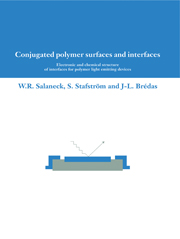 Conjugated Polymer Surfaces and Interfaces
Conjugated Polymer Surfaces and Interfaces Book contents
5 - Device motivation for interface studies
Published online by Cambridge University Press: 12 January 2010
Summary
Introduction
The application we have in mind for the metal–polymer interfaces discussed in this book is primarily that where the polymer serves as the electroactive material (semiconductor) in an electronic device and the metal is the electric contact to the device. Metal–semiconductor interfaces, in general, have been the subject of intensive studies since the pioneering work of Schottky, Strömer and Waibel, who were the first to explain the mechanisms behind the rectifying behaviour in this type of asymmetric electric contact. Today, there still occur developments in the understanding of the basic physics of the barrier formation at the interface, and a complete understanding of all the factors that determine the height of the (Schottky) barrier is still ahead of us.
The aim of this chapter is to present a simple but general band structure picture of the metal–semiconductor interface and compare that with the characteristics of the metal–conjugated polymer interface. The discussion is focused on the polymer light emitting diode (LED) for which the metal–polymer contacts play a central role in the performance of the device. The metal–polymer interface also applies to other polymer electronic devices that have been fabricated, e.g., the thin-film field-effect transistor, but the role of the metal–polymer interface is much less cruical in this case and therefore less relevant for detailed studies of the type discussed here.
The materials (metals and conjugated polymers) that are used in LED applications were introduced in the previous chapter.
- Type
- Chapter
- Information
- Conjugated Polymer Surfaces and InterfacesElectronic and Chemical Structure of Interfaces for Polymer Light Emitting Devices, pp. 64 - 71Publisher: Cambridge University PressPrint publication year: 1996


